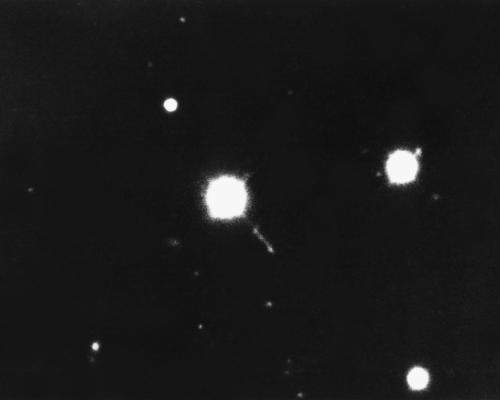Quasar 3C 273 and its relativistic jet: a truly exceptional image – 25 April 2025.
Working under good sky conditions, we captured an exceptional image, something impossible to do just a few years ago: the relativistic jet of quasar 3C-273, showing fine details.
The image above comes from the average of ten, 300-second exposures, unfiltered and unguided, remotely taken with the C14+Paramount ME+ST-10XME robotic unit available as part of the Virtual Telescope Project facility in Manciano, Italy. The image was carefully processed to show the faint relativistic jet emerging from the quasar.
This is one of those images that, at first glance, might easily go unnoticed. A photograph that appears to reveal nothing of particular interest: a few stars scattered across the dark background of the sky. And yet, as often happens when observing the universe, appearances can be deceiving.
The celestial body at the center of the frame, seemingly unremarkable and star-like in appearance, is in fact one of the most extraordinary and significant objects ever discovered by humankind: it is 3C 273, the first quasar (a contraction from “quasi-stellar radio source”) ever identified. A true milestone in the history of modern astronomy, 3C 273 is also the brightest quasar visible from Earth and one of the most luminous known in the universe.
This remarkable object lies at the staggering distance of approximately 2.7 billion light-years from Earth — a glimpse into the distant past, showing us the quasar as it was when the first multicellular organisms were just beginning to evolve on our planet.
From that immense distance, 3C 273 emits an unimaginable amount of energy: it is roughly 200 times more luminous than the Milky Way, the massive galaxy that hosts our Solar System. If 3C 273 were located only 30 light-years away — a distance comparable to that of the star Pollux in the constellation Gemini — its apparent brightness would rival that of the Sun.
And now comes the fascinating detail — quite literally, a needle in a cosmic haystack.
Upon close inspection of the image, a faint luminous jet can be discerned, extending from the quasar toward the 4 o’clock position. This is not merely a beam of light, but a relativistic jet of ionized matter, ejected at velocities approaching the speed of light. This phenomenon results from the interaction between the supermassive black hole at the center of 3C 273’s host galaxy and the accretion disk of matter spiraling into it — a textbook example of an active galactic nucleus.
The extraordinary nature of this image becomes even more apparent when compared to observations made roughly thirty years ago with the renowned 4-meter Mayall Telescope located at Kitt Peak, Arizona — an instrument ten times larger than the one used to capture the current image. This comparison highlights the significant advancements in astronomical technology over time, particularly in the field of digital imaging: today, relatively modest instruments can achieve results that once required massive and prohibitively expensive observatories.

3C 273 imaged with the 4-m Kitt Peak reflector about 30 years ago: it shows the same features of our image. (Credit: AURA/NOAO/NSF).
This image was captured in Manciano (province of Grosseto), under the clearest and most pristine skies in peninsular Italy — a place where the absence of light pollution still allows the night sky to be admired in all its poignant beauty.
Support The Virtual Telescope Project!
Support us! Please, donate and receive an EXCLUSIVE image of the stunning COMET C/2023 A3 Tsuchinshan-ATLAS and much more, specifically made for supporters like you!
![]()











